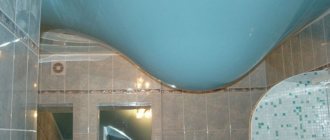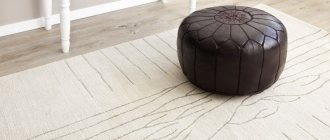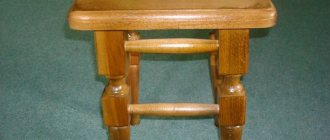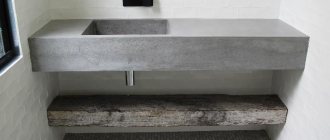Do you want to make a beautiful lambrequin, but don’t know which shape to choose? Make swags with your own hands. You can take ready-made patterns or make your own according to size. The pleated semicircle is a classic that never goes out of style. Curtain salons offer such products, but it is not always possible to choose the right model, and sometimes custom-made ones are too expensive. If you are interested in how to make swags with your own hands, read on.
Types of products and their main parameters
This lambrequin element is a semicircle with folds. The swag consists of a middle, two shoulders and has depth. The shoulder is located along the cornice, and depth refers to the distance by which the fabric falls from the top line down.
Swags are of the following types:
- symmetrical;
- asymmetrical;
- with a vertical shoulder;
- mechanical;
- with sagging;
- turning into de jabot.
You can try to make a simple symmetrical swag even without a pattern, but a mechanical fold is obtained using curtain (mounting) tape.
Sequencing
Whatever version of the product you choose, usually sewing a swag with your own hands consists of the following steps:
- Selecting a suitable model and drawing up a diagram.
- Taking measurements and calculating the size of the swag and the amount of material.
- Constructing a pattern or scaling a finished template.
- Positioning the part on the fabric (this is always done diagonally) and cutting.
- Creating folds.
- Sewing seams, finishing edges, hemming curtain tape or Velcro for attaching to the cornice.
The work at each stage may differ slightly, but in general the scheme always remains approximately the same.
Size calculation
To make swags with your own hands (patterns using a ready-made template or making them yourself), you need to correctly determine all the parameters of the product. Calculations can be made using equations or a scale drawing.
If you are planning to have a lambrequin (swag), you need to know:
- cornice length;
- half the length of the lower sag (the arc of the hanging edge);
- depth, that is, the distance by which it “hangs” from the top line.
All this just needs to be measured using a window or a scale diagram.
If the lambrequin consists of several swags, you will have to make some calculations. Suppose the length of the cornice is 3.6 m, and you want to place 4 swags that overlap the adjacent one by 1/3. This is the minimum intersection value. If done without them, you need to divide 3.6 m by 4. In the case of overlapping parts, three overlaps of 1/3 each arise, that is, in fact, this is the size of one swag, so the length of the cornice is divided by 3. The size of the element is equal to 1 .2 m.
For symmetrical swags, a pattern is drawn for half the product, which is applied to the fabric folded in half.
For asymmetrical, a single blank is made, but the dimensions of each part, if there are several of them, must be calculated in advance.
The simplest method
The first thing you need to learn is that the swag pattern is made exactly at an angle of 45 degrees. Cutting a swag like this is not difficult, and the resulting fabric, when folded in the correct way, will allow you to get wonderful folds that will also decorate the window. If the fabric is covered with patterns or designs, then it is unlikely to be cut at a certain angle - it will not be possible to maintain the harmony of the pattern. Here it is customary to use a slightly different technique; you need to look at the main threads. Well, don’t forget about the proportions - collecting swag disproportionate means ruining it in the bud.
In order for the proportions to be correct, you need to adhere to certain rules:
- The length of the curtain sag should be equal to the width;
- The folds must be the same depth, then the size will be the same and accurate.
If you want to make the curtain pronounced, then you should cut the swag for the lambrequin along an oblique line, then the look will be much more impressive.
Making the right swag means delving into a long and multifaceted process. One such type looks bad, but sewing it so that this option is combined with curtains and lambrequins is a more difficult task. And the lambrequin itself also needs to be made correctly, otherwise it will not fit into the composition with the curtains. This also means that a lambrequin for certain types of swag must have the exact number of folds along the length. Therefore, it will take a lot of effort to combine this into a single composition.
Swag and curtains in the living room
Improving your skills
Patterns for an asymmetrical swag, like any other one, never come out quickly for beginners. Quickly make cuttings, immediately guess the number and depth of folds - this comes with years and hundreds of completed models. But if you spend time, then having learned how to make swags and lambrequins, sewing curtains is no longer a difficult and impossible task for you. You can even safely get a job at a design agency - they value those who implement ideas on their own right on the spot.
If at first glance this seems like overwhelming work to you, then we hasten to please you - there is a special technique for sewing lighter versions of curtains, which are called mechanical swag. The secret is that there is no need to lay each fold manually; it is done using a special mounting tape. So we’ll figure out how to cut a mechanical type swag using such a curtain tape.
Scheme
It’s worth making it a rule to make sketches of future lambrequins. This helps to choose the best arrangement of elements and their proportions in accordance with the size of the window, cornice, curtains. It is better to carry out the diagram on a scale, for example, 1:10. In this case, a three-meter lambrequin on paper will be equal to 30 cm.
If you adhere to this rule, it will not be difficult for you to find out any size of the lambrequin component. To do this, you just need to measure it with a ruler or count the number of cells of graph paper and multiply by the scale value.
You can carry out all constructions on a computer in a graphic editor or a specialized program NanoCad, which allows you to obtain drawings, patterns of curtains and their components with sizing.
How to make a swag without a pattern
Do you want to make a round lambrequin? It’s easy to make swags with your own hands. For beginners, we can offer this option:
- Fold a square of light fabric (organza, veil) diagonally and mark the fold in the middle.
- Take a strip on which you mark the width of the swag, the middle and the shoulders. Hang the fabric at a forty-five degree angle. To see the center, hang a weight.
- Carefully form and pin the first fold. Make a “roller” approximately 10-15 cm in size.
- Make all other folds, maintaining symmetry and the same distance between them.
- Trim away any excess fabric and pin the top edge frequently along the pleat pinning line.
- Finish the bottom with bias tape or another method.
- Sew Velcro or curtain tape on top.
Getting even folds the first time may not be so easy, but it's worth practicing.
LiveInternetLiveInternet
We take a ready-made swag pattern, which you can make yourself if you read the section “Constructing an equilateral swag pattern” or purchase it from me on the page: READY-MONEY PATTERNS. This is what a swag pattern :
swag pattern
1. The swag pattern is applied to the fabric on the bias; to do this, we place the fabric on the corner, like this:
Master Class
how to collect swag
2. The swag pattern is transferred to the fabric, cut out and this is what should happen:
swag pattern
3. We process the lower sag of the swag with bias tape, trying not to stretch the fabric:
Master Class
4. Now, before assembling the swag, we must iron it, since we will not have such an opportunity in the future.
After ironing, leave the cut swag to cool for 10-15 minutes so that the fabric does not wrinkle during assembly:
5. After the fabric has cooled, place the swag on a cutting table or any horizontal surface, and begin laying folds, starting with the first. You can fix the folds with tailor's pins or basting:
how to collect swag
how to collect swag
how to collect swag
When we have pinned both sides, we place them under the foot of the sewing machine and secure the folds with a line:
When everything is fixed with a stitch, we hang the swag on a measuring board or on a bar.
The swag is ready and waiting to add other lambrequin elements:
swag
However, the folds in the swag can also be laid on the mounting plate (for me, for example, this is more convenient).
When laying folds in the swag, be sure to follow the dimensions of the swag's shoulder length. For example, the following size is given: the length of the swag along the cornice is 100 cm (30-40-30) with 5 folds. This means that you need to lay out the shoulders exactly 30 cm. And when cutting and subsequent ironing, the fabric is stretched, and the teeth of the folds become not the same, as in the sent pattern - somewhere more, somewhere less. How do you still keep your shoulder size? When laying folds in a swag, you just need to observe the fold pitch (the distance between the folds).
I'll show you clearly. When we have cut out the swag, ironed the fabric, we begin to lay out the folds, according to this lesson.
However, I put folds on the mounting strip (bar). It's more comfortable for me. I hang the middle of the swag on a block:
I make the first fold according to the pattern:
Next, from this fold I outline the step of the fold. Let's use the example of equilateral swag No. 10.
Length along the cornice 110 cm (43-24-43), sag height 70 cm, 8 folds, fold pitch 4.7 cm:
This size is 4.7 cm and you need to mark from the first fold and lay the second fold:
We do the same with all subsequent folds until we get a finished swag:
That's all.
And finally, I invite you to watch a video in which I show how to correctly cut and conveniently assemble a swag:
How to make a pattern
If you don’t want to cut off a lot of excess fabric, you should use another method to sew swags with your own hands. Patterns will help you cut out the finished part and form folds from it.
The following constructions are performed:
- Mark a point and draw a right angle from it.
- Set aside a distance to the right equal to half the middle of the swag, adding 3 cm for processing.
- Measure down the depth of the product, multiplied by a factor that is 2 for hard, difficult to drape fabrics and 2.5 for soft, easy to drape.
- From the starting point, draw a circular arc with the radius of the vertical segment obtained in the previous step.
- From the bottom point, set aside a distance along an arc equal to half the bottom sag with an addition of 3 cm for processing. Close the contour with the resulting mark.
This is how a blank is made, for example, for a mechanical symmetrical swag.
An alternative option for sewing swag
If you are looking for a simple option on how to sew swag curtains, we recommend the following method. To begin with, you should sew with your own hands, the simplest lambrequin with sagging, which will replace the curtains. Next you need to follow the instructions:
- To calculate the required yardage of fabric, you need to measure the cornice and add 12 cm to the figure. You should also add the length of the decorative elements hanging along the edges of the swag, which will act as curtains. The width of the material depends on the depth of the curtain sag in the photo. With a sagging depth of 60 cm, the width of the canvas should be at least 80 cm.
- To make the lambrequin rigid, it is necessary to use lining material.
- Having folded the main material and the lining with the right sides, you should sew them along the edge, leaving 30 cm on top of the fabric. As a result, a long rectangular piece of fabric should be formed.
- At the corners of the lambrequin, you need to make cuts and turn the product right side out.
Use a ready-made template
If you are new to this business, in order to properly sew a swag with your own hands, it is better to take ready-made patterns. Now computer technology has greatly simplified search and work.
You can print the version you like in the desired scale on a printer. There are two ways:
- Make a pattern in parts on landscape sheets of home printing equipment.
- Order from a company that provides large-format image production services.
In the first case, you will do everything without leaving home, but you will have to glue the sheets with tape. In the second option, you won’t have to connect anything, but you will have to spend extra money.
Making swags
Sewing a swag is not an easy task and you will have to try hard. If you add a curtain lambrequin to it, then the design will look good and complete. However, it is worth knowing that the proportions between the swag and the lambrequin must be respected in order for the picture to look harmonious. To make it work well, you need to cut the swags into the curtains in advance and count the required number of festoons.
Related article: Ways to cover a balcony with siding from the outside with your own hands
The festoons should look harmonious in the end, as if creating an overall favorable picture. The pattern, every detail and folds in this case require skill and accuracy so that the final result is good. Patterning an asymmetrical swag for beginners will reveal the intricacies of the manufacturing process and finishing it to the desired look. You will have to try hard, but once you have mastered the complex process, you will no longer be able to refuse such elegant curtains.
How to cut swag with your own hands
So, you have chosen a template or built it yourself, cut it out of paper. Now the most important thing is to correctly position the parts on the fabric.
This is done diagonally. As a rule, the pattern should indicate the direction of the grain thread with an arrow. So do this:
- Fold the fabric diagonally into a scarf shape.
- Attach the pattern to the fold line.
- Pin it in place with pins.
- Trace the edges with chalk or soap, do not forget about allowances in the right places.
- Cut out the workpiece.
Work is done. Now you know how to cut a swag with your own hands. You can begin forming folds and sewing.










